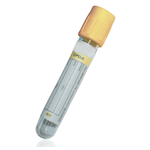Suitable Specimen Types
- Serum
Specimen Transport
Usual transport to laboratory.Sample Processing in Laboratory
Separated serum sent daily to referral laboratory via usual transport.Sample Preparation
Centrifuge sample and separate serum.Turnaround Time
5 working daysSample Stability
Separate sample promptly (stable at RT for several hours in whole blood). Store separated serum samples at 4ºC.Androstenedione
General Information
Androstenedione (also known as D4-androstenedione)is a steroid which serves as a major precursor for the androgen testosterone and oestrogens oestrone and oestrodiol. Its clinical interest derives from the fact that it is often elevated in cases of abnormal hair growth (hirsutism) and virilization. Unlike the adrenal androgens dehydroepiandrosterone and its sulphate, circulating androstenedione originates both from the adrenals and from the ovaries. The production of adrenal androstenedione is governed by ACTH, while production of gonadal androstenedione is under control by gonadotropins. Plasma levels increase steadily from about the seventh year of life. In premenopausal women the adrenal glands and ovaries each produce about half of the total androstendione (about 3 mg/day). After menopause androstenedione production is about halved, primarily due to the reduction of steroid secreted by the ovary. Androstenedione exhibits a diurnal variation, being highest in the morning, and also a cyclical variation during the menstrual cycle, being highest near mid-cycle. During pregnancy, there is an increase in the plasma level.
Patient Preparation
Collect blood 1 week before or after menstrual period.
Reference Range
(supplied by referral laboratory):
Adults
Female (pre-menopause): 0.9-7.5 nmol/L
Female (post-menopause): 0.4-2.9 nmol/L
Male (18:40yrs): 1.1-5.6 nmol/L
Male (41-67yrs): 0.8-4.7 nmol/L
Paediatrics
Neonates: <8.0 nmol/L
Female tanner stage 1: <1.9 nmol/L
Male tanner stage 1: <1.1 nmol/L
Elevations can be found in premature babies
Source of Reference Range
Provided by Reference LaboratorySpecifications
- EQA Scheme?: Yes
- EQA Status: NEQAS
